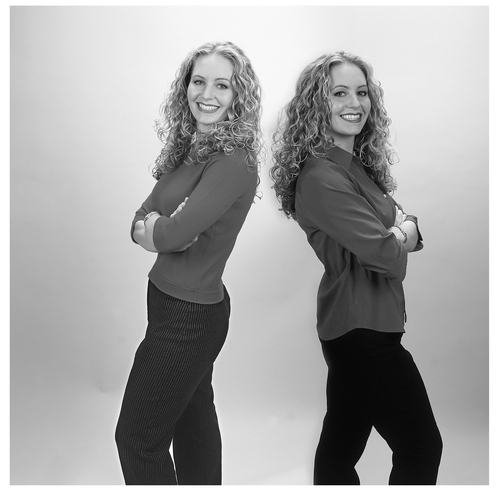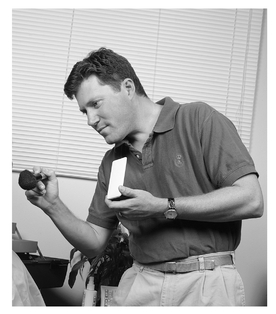41
Makeup and Wardrobe
Bill Davis

Figure 41-1
I remember watching an interview on television that featured a world famous supermodel. During the interview, she said something that surprised me. “I sure wish I looked like that.” The picture she was talking about was a major magazine cover featuring her. She went on to explain that the picture was the result of hours of careful work by a team of professionals including both wardrobe and makeup stylists.
It reminded me that no matter how good someone looks naturally, there are “tricks of the trade,” that can help make them look even better. In that spirit, let’s take a close look at wardrobe and makeup — two of the most overlooked elements that can enhance the look of your videos.

Figure 41-2 Wardrobe worries: Always be aware of the wardrobe in which your talent is dressed. Traditionally, deep reds don’t hold up well in video. Even as technology improves, reds have a tendency to bleed. Also, tight patterns can make your viewers seasick with the moiré effect. Blue tones have a pleasant lighting quality while details are completely lost in solid black.
Dress for Success
In movies, academy awards are given out for doing an excellent job of finding or creating precisely the right clothes for the cast of a movie. For most of us, costuming for our videos is nowhere near that difficult. In fact, in most cases we just shoot whatever our “actors” happen to show up wearing.
But if you want your videos to be as good as they can possibly be, you should never leave any important element to chance. And wardrobe is certainly no exception. After all, the clothing your actors wear can have a big effect on the technical quality of your video. Remember that your camera is a light-gathering device. Depending on the amount of light that strikes the image sensor, the iris will need to open or closed to achieve the proper exposure. This technical truth means that the wardrobe you choose can literally change what your camera needs for a good exposure.
Think about it. If the actor is wearing a pure white T-shirt, that shirt is reflecting the maximum amount of light back into the camera lens. Confronted with this bright subject, the iris closes. Everything else in the scene gets correspondingly darker, the background, the foreground and, even worse, the very face of your subject. This will particularly problematic if your subject has dark skin. When the iris is adjusted to expose the white shirt, everything else in the shot becomes darker, and dark colored items may become lost in blackness, including your subject’s face. All this is simply because the major element in the scene, the talent’s T-shirt is white.
And, of course, the opposite is true. Put a light-skinned talent in a navy blue or black shirt, adjust the exposure for the dark shirt, and white objects will be over exposed and blown out. For these reasons, it’s best to put your talent in clothing that falls in the medium range of brightness and hue. Pastel colors work particularly well in video. As do medium grays and blues since the light reflecting qualities of shades such as these help you establish a good exposure.
Check Out Checks
The relative brightness of your cast’s wardrobe isn’t the only factor that can help or hurt your video. Some kinds of clothing patterns look just terrible on video. Thin spaced lines or small repetitive patterns can cause a distracting moiré pattern to appear in your shots. Moiré areas are where the picture seems to crawl or vibrate with a rainbow-like pattern. If you see moiré develop while you’re shooting, you can often get rid of it by either zooming in or out. But if you need to zoom back later, the problem will re-occur. Clothing can also have an effect on how the audience perceives your subject. If a person is supposed to be a successful businessman and he’s on screen wearing a poorly-cut, ill-fitting or out-of-style suit, you’ll have a hard time convincing your audience to take his business advice seriously.

Figure 41-3 Touch ups—you can see the makeup on a person in regular lighting. However, when they’re under the lights, it’s nearly invisible, with the effect of warming skin tones and highlighting facial features.
Just Make it Up
A large percentage of the population (typically women) wear makeup every day. Professional directors wouldn’t dream of shooting screen actors without makeup. In the professional realm, not wearing makeup is just not an option. So it’s surprising that more videographers don’t use this valuable tool to enhance the look of people appearing in their videos.
Most of the time the natural look is best, and very little makeup is necessary. The goal is merely to minimize distracting elements such as skin blemishes and provide your talent with a smooth, healthy look. While every drug store carries hundreds of shades of makeup, you might be surprised to learn that many of these tones are decidedly video unfriendly.
If you’ve been making videos for any length of time, you already know that what the camera sees is often very different from what is perceived by the

Figure 41-4 Safety first! One area that’s particularly important to understand when applying makeup is sanitation. Since makeup tools are commonly used in sensitive areas such as around the eyes, it’s quite possible to spread germs and even infections if the same application tool is used for more than one subject. There are plenty of safe and inexpensive ways to keep things sanitary. Disposable makeup sponges are readily available in any drug store. Always think safety first, and make “one tool equals one person” a rule you live by.
human eye. According to Mary Wright, a Phoenix-based professional makeup artist who’s plied her trade for a gamut of celebrities including Michael Jordan, Annette Funicello, and even Scary Spice, the pros go to great lengths to carefully match the makeup they use with the kind of lighting that will be in use.
“Some types of light that look fine to the eye, can look greenish, golden or reddish to a camera. Makeup can work the same way. By applying makeup with the wrong base tones, you can conceivably make a shot that looks good to the naked eye look very wrong on camera,” she said.
Avoid makeup that incorporates green hues if you’ll be working under fluorescent lights. If you’re shooting outdoors and have white balanced your camera for daylight and are using a lamp—which is more golden—to provide fill light, makeup with strong yellow tones can make talent look ill and jaundiced. For these reasons, professionals typically use specially formulated video and film makeup that avoids color tones that can cause on-camera problems.
Makeup Basics
Along with establishing a smooth foundation, you need to consider whether your talent has any serious cosmetic flaws. If someone has a distracting facial blemish there are concealers available that can diminish or even eliminate the appearance of these visual challenges from showing up on screen. It’s important to match these cosmetics with the subject’s skin tones. Fortunately there are literally thousands of shades of makeup allowing for a good match with the natural complexion of nearly any subject you’re likely to videotape. Professional makeup artists carry a bewildering array of makeup shades to match the wide array of skin tones that are reflected in our diverse society, but for the beginner, a few neutral shades that compliment the likely complexions of your cast members or interview subjects should be fine.
Along with the makeup itself, you’ll need the tools with which to properly apply it. Small sponges, soft brushes for powder, and fine brushes for work around the eyes are all tools that every makeup kit will typically contain. So too are plenty of tissues and makeup removal products to help clean up after you yell, “That’s a wrap!”
Going beyond these basics and using makeup to create highlights, shadows and colors and to help enhance, diminish and define facial features is beyond the scope of this chapter. However, spending some time learning the basics of video-friendly wardrobe and practicing the application of on-screen makeup, you will be prepared when it’s time to turn your camcorder toward a person who needs to look their best.

Figure 41-5 Executive makeup: in many cases, the most difficult subjects for makeup will be male corporate executives, industry leaders and other men in significant positions. For them, using makeup might be perceived as “phony” or less than masculine. When you find yourself in this situation, communication and tact are critical. First, it’s important to help them understand why makeup is important. Calmly explain that hot video lights can make people perspire and that leads to an unsightly condition that a little light powder can help avoid. If they still object, remind them that people associate perspiration with nerves and nervousness with dishonesty. That usually does the trick. Once they agree to use makeup, it’s critical to apply it quickly, efficiently and professionally. If at all possible, leave the office or set and apply the makeup somewhere privately. Avoid the possibility of making an executive feel foolish in front of his or her staff by having them watch during a makeup application.
